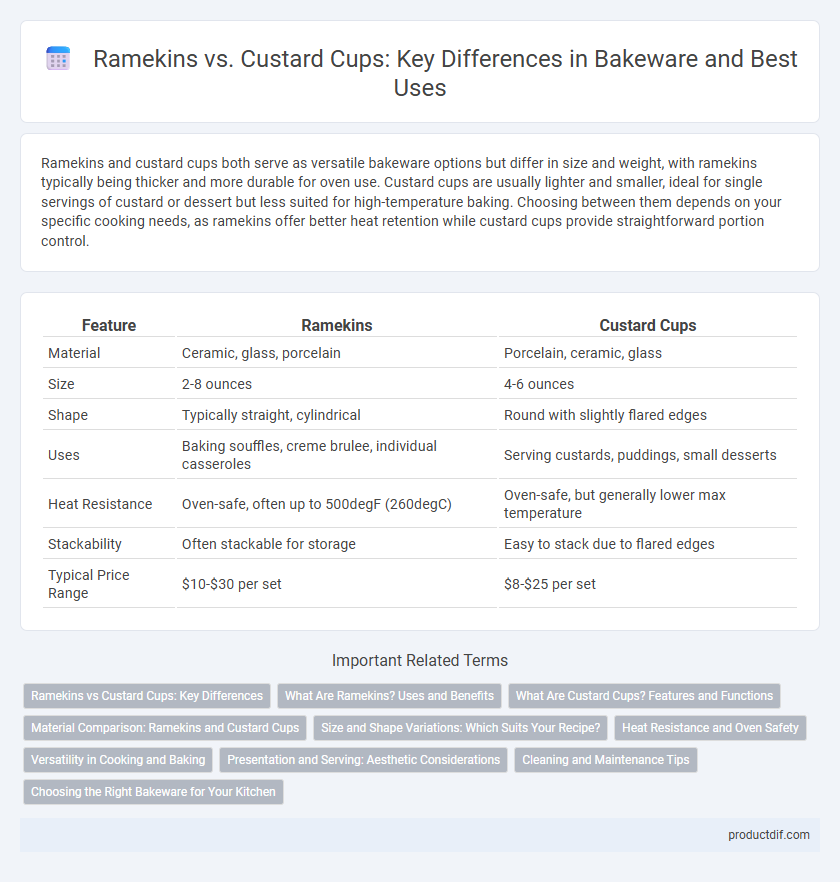Ramekins and custard cups both serve as versatile bakeware options but differ in size and weight, with ramekins typically being thicker and more durable for oven use. Custard cups are usually lighter and smaller, ideal for single servings of custard or dessert but less suited for high-temperature baking. Choosing between them depends on your specific cooking needs, as ramekins offer better heat retention while custard cups provide straightforward portion control.
Table of Comparison
| Feature | Ramekins | Custard Cups |
|---|---|---|
| Material | Ceramic, glass, porcelain | Porcelain, ceramic, glass |
| Size | 2-8 ounces | 4-6 ounces |
| Shape | Typically straight, cylindrical | Round with slightly flared edges |
| Uses | Baking souffles, creme brulee, individual casseroles | Serving custards, puddings, small desserts |
| Heat Resistance | Oven-safe, often up to 500degF (260degC) | Oven-safe, but generally lower max temperature |
| Stackability | Often stackable for storage | Easy to stack due to flared edges |
| Typical Price Range | $10-$30 per set | $8-$25 per set |
Ramekins vs Custard Cups: Key Differences
Ramekins and custard cups both serve as small, oven-safe containers for individual portions, but ramekins typically feature straight sides and a more durable, thicker construction suited for baking and broiling. Custard cups often have a flared or rounded edge and thinner walls, making them ideal for delicate desserts like custards and serving rather than high-heat cooking. Ramekins usually come in sizes ranging from 4 to 8 ounces, while custard cups are often smaller, around 3 to 6 ounces, influencing their specific use cases in the kitchen.
What Are Ramekins? Uses and Benefits
Ramekins are small, oven-safe ceramic or glass dishes typically used for baking individual portions of dishes like souffles, creme brulee, and custards. Their heat-resistant properties ensure even cooking and easy portion control, making them ideal for both savory and sweet recipes. The versatility and durability of ramekins enhance presentation and simplify preparation and serving in both home kitchens and professional settings.
What Are Custard Cups? Features and Functions
Custard cups are small, heat-resistant ceramic or glass containers designed for individual servings of custards, puddings, and other baked desserts. They typically feature straight or slightly flared sides, a wide rim, and a capacity ranging from 4 to 8 ounces, making them ideal for portion control and even baking. Their design allows for easy handling in ovens and water baths, ensuring consistent heat distribution for delicate recipes.
Material Comparison: Ramekins and Custard Cups
Ramekins and custard cups are commonly crafted from materials such as ceramic, porcelain, and glass, offering excellent heat retention and even cooking for delicate dishes. Ceramic ramekins typically feature thicker walls, which help maintain consistent oven temperatures, while glass custard cups allow for easy visual monitoring of the cooking process. Both materials are oven-safe and dishwasher-friendly, making them versatile choices for baking and serving individual desserts or savory items.
Size and Shape Variations: Which Suits Your Recipe?
Ramekins typically range from 4 to 8 ounces and feature straight sides ideal for even baking and presentation of individual portions, while custard cups are smaller, generally 3 to 6 ounces, with wider mouths and gently sloping sides designed for delicate custards and desserts. The choice between ramekins and custard cups depends on the recipe's portion size and texture, as ramekins support firmer dishes like souffles or creme brulee, whereas custard cups excel with softer, more fluid desserts. Consider the baking method and final presentation when selecting the appropriate size and shape to enhance both cooking performance and aesthetic appeal.
Heat Resistance and Oven Safety
Ramekins and custard cups typically differ in heat resistance, with ramekins often made from thicker, high-quality ceramic materials designed to withstand high oven temperatures up to 500degF (260degC). Custard cups, while also oven-safe, generally tolerate slightly lower temperatures around 350degF to 400degF, making them ideal for gentle baking tasks. Ensuring the product specifications confirm oven safety is crucial for preventing cracks or breakage during cooking.
Versatility in Cooking and Baking
Ramekins offer greater versatility in cooking and baking due to their larger size and heat-retaining ceramic material, making them suitable for souffles, creme brulee, and individual pot pies. Custard cups are typically smaller and designed specifically for custards and smaller desserts, limiting their use to lighter applications like puddings and mousse. Both can be used interchangeably in some recipes, but ramekins provide broader culinary flexibility.
Presentation and Serving: Aesthetic Considerations
Ramekins offer a refined, classic presentation with their fluted exteriors and thick walls, enhancing the visual appeal of desserts like creme brulee or souffles during serving. Custard cups, typically simpler and smoother, provide a minimalist aesthetic that suits casual or rustic dining settings, emphasizing the dessert itself over the vessel. Choosing ramekins elevates formal occasions, while custard cups complement everyday meals with understated elegance.
Cleaning and Maintenance Tips
Ramekins typically have thicker walls and a glazed finish that resists staining, making them easier to clean compared to thinner, unglazed custard cups which may retain residue and require more thorough scrubbing. To maintain bakeware longevity, soak both ramekins and custard cups in warm, soapy water immediately after use to prevent baked-on food buildup. Avoid abrasive cleaners or metal scrubbers which can damage the glaze on ramekins, while non-stick custard cups need gentle cleaning to preserve their coating.
Choosing the Right Bakeware for Your Kitchen
Ramekins and custard cups both serve unique roles in bakeware, with ramekins typically crafted from ceramic or porcelain for even heat distribution, ideal for souffles and creme brulee, while custard cups are often smaller and suited for individual servings of custard or pudding. Selecting the right bakeware depends on your cooking style and recipe requirements, as ramekins offer better heat retention and durability, whereas custard cups provide versatility for chilled desserts. Understanding the material, size, and heat tolerance of each option helps optimize baking results and kitchen efficiency.
Ramekins vs Custard Cups Infographic

 productdif.com
productdif.com